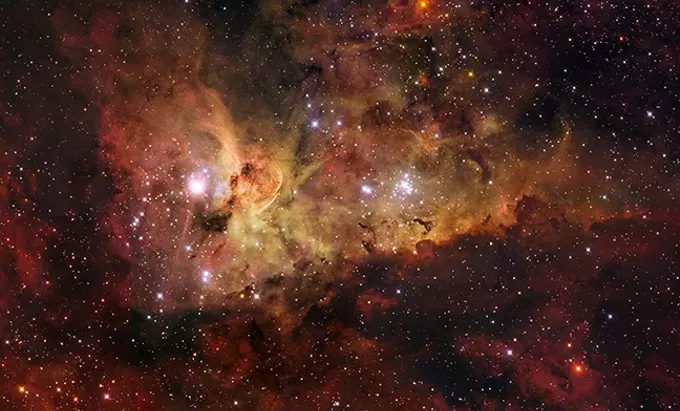Nearly two centuries ago, astronomers witnessed the explosive death of one of the brightest star in our galaxy—or so they thought.
Eta Carinae is a stellar system that seemingly went through a supernova in the mid-1800s, yet is still around to tell the tale. But how? Astronomers at UA’s Steward Observatory are making the most of a fascinating phenomenon to look back in the past and figure out the mystery of the star that won’t die.
A “Light Echo” is when light bounces off celestial bodies before reaching Earth, essentially taking longer than it normally would to reach us. This delay allows astronomers to, in a sense, look back in the past at Eta Carinae’s great eruption.
First off, Eta Carinae is a binary star, which means it’s actually two stars in close orbit that can look like a single star to the untrained eye. Using data gathered from light echoes, UA astronomers theorize that the supernova witnessed in 1837 wasn’t the death of a single star, or even of a binary star, but an energy transfer between three stars.
In this proposed scenario, two large stars orbit closely together while a third star orbits in the distance. When the largest of the two binary stars begins to die, it expands and transfers most of its material onto its slightly smaller sibling, thus resulting in the two extant stars post-supernova that we see today.
Extra: About the photo: The Carina Nebula is a large bright nebula that surrounds several clusters of stars. It contains two of the most massive and luminous stars in our Milky Way galaxy, Eta Carinae and HD 93129A. Located 7500 light years away, the nebula itself spans some 260 light years across, about 7 times the size of the Orion Nebula, and is shown in all its glory in this mosaic. It is based on images collected with the 1.5-m Danish telescope at ESO's La Silla Observatory. Being brighter than one million Suns, Eta Carinae (the brightest star in this image) is the most luminous star known in the Galaxy, and has most likely a mass over 100 times that of the Sun. It is the closest example of a luminous blue variable, the last phase in the life of a very massive star before it explodes in a fiery supernova. Eta Carinae is surrounded by an expanding bipolar cloud of dust and gas known as the Homunculus ('little man' in Latin), which astronomers believe was expelled from the star during a great outburst seen in 1843.
[
{
"name": "Air - MedRect Combo - Inline Content 1",
"component": "29441156",
"insertPoint": "1/3",
"requiredCountToDisplay": "9",
"parentWrapperClass": "fdn-ads-inline-content-block"
},{
"name": "Top Stories Video Pair",
"component": "27651162",
"insertPoint": "10",
"requiredCountToDisplay": "1",
"parentWrapperClass": "fdn-ads-inline-content-block"
},{
"name": "Air - MedRect Combo - Inline Content 2",
"component": "29441158",
"insertPoint": "2/3",
"requiredCountToDisplay": "10",
"parentWrapperClass": "fdn-ads-inline-content-block"
},{
"name": "Air - MedRect Combo - Inline Content 3",
"component": "29441159",
"insertPoint": "1000",
"requiredCountToDisplay": "15",
"parentWrapperClass": "fdn-ads-inline-content-block"
}
]


